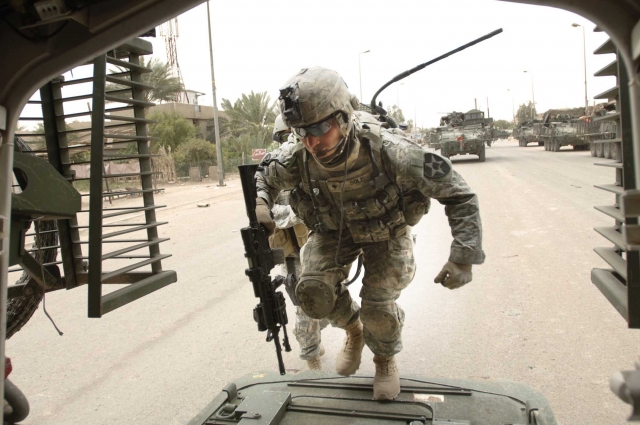
AUSA: A new generation of generals is rising in the Army. It’s a generation forced to get creative by more than a decade of ugly unconventional conflicts. It’s a generation disillusioned by the mistakes of superiors, military and civilian alike. It’s a generation willing to take on the Army’s bureaucratic culture of top-down management, which dates back to Elihu Root becoming Secretary of War in 1899.
But can they shift the notoriously slow-moving service? “I think the Army would acknowledge they are in the earliest stages of figuring out how to design and field the force we will need in the future,” Michele Flournoy, former Under Secretary of Defense for Policy, told my colleague Colin Clark today at the Bipartisan Policy Center.
To make change stick in the largest service, you have to start by rewriting holy writ, the service’s official doctrine. For the first time, for example, an official Army Operating Concept — published just this month — addresses the problem that’s bedeviled the military since Vietnam: how to turn tactical victories into strategic success. “That was a very deliberate decision [to include],” Gen. David Perkins, head of the Training and Doctrine Command (TRADOC), told reporters during the new concept’s roll-out at the annual Association of the US Army conference. “We are very, very good at the operational and tactical level,” Perkins said, “[but] this was written by people who’ve actually done this since 9/11, and we realize that actually the operational and tactical level of war is inadequate. It’s important, but it is inadequate to get at what the Army needs to provide our nation.”
“That’s why we start with Win In A Complex World,” the title of the new concept , Perkins said: “‘Win’ is a strategic-level construct.”

Gen. David Perkins, TRADOC commander.
The Army’s not only adding a new emphasis on strategy, it’s taking away a longstanding emphasis on top-down control. In fact, the venerable term “command and control” itself is gone, replaced by “mission command.”
In military jargon, “control” meant making sure your subordinates followed orders: That’s still necessary, but it’s far from sufficient for a world so complex and quickly changing that no commander, staff, or war plan can keep up, Gen. Perkins told me. Enforcing “compliance to specific orders” is less important than forging “a common understanding” between superiors and subordinates,” he said. Wireless networks are the Army’s top investment priority because they help share and update this common understanding — when they work, Perkins added wryly — but it has to start with a meeting of human minds.
Perkins himself exercised extraordinary initiative — to the point some old-school commanders might consider insubordination — as a brigade commander spearheading the US drive into Baghdad in 2003. (More on that below). 11 years and four stars later, he’s now, since March, the chief of TRADOC, the oft-hidebound priesthood of the Army. His deputy is no less an iconoclast than Lt. Gen. H.R. McMaster, whose career was once nearly killed by traditionalist promotion boards.
Are the inmates running the asylum? They’re certainly driven to shake things up.”It is not a feel-good document,” Perkins said of the new concept. “It is meant to be a very serious document written by very serious people… who have seen a lot of blood spilled since 9/11 and are very serious about really capturing the essence of war.”
“It’s in our doctrine now, because we know the world is unknown and constantly changing, [that] you can’t possibly control compliance with everything,” Perkins told reporters at the service’s largest gathering, the annual Association of the US Army conference. “You have got to figure out how you empower subordinates to exploit the initiative.”
“It’s not chaos. It’s not ‘cross the line of departure and everybody self-actualize,’ because that’s not empowering,” Perkins told me. “If you want to empower somebody, you better have a common understanding of what you think the problem is, [so] you understand where you can take initiative” — for example, by taking a hill or visiting a sheikh — “and where you can’t” — say, by shelling a mosque or violating an international border.
If you read an Army “Case Study in Mission Command” that Perkins commissioned, that leeway can be wide indeed.
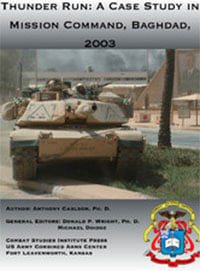 A Surprising Turn
A Surprising Turn
In April 2003, as his brigade made ready for the second “Thunder Run” into Baghdad, then-Colonel David Perkins had a plan. It wasn’t a plan his superiors had approved. It was, in fact, a plan the three-star commander of all ground troops in Iraq had “dismissed” when the colonel presented it through the usual channels, according to the official Army case study. So Lt. Gen. William Wallace was understandably “stunned” when he watched the GPS-tracked positions of Perkins’ brigade turn right towards downtown Baghdad instead of making the expected U-turn to leave the city.
Wary of urban warfare, for good reason, the generals had decided to besiege Baghdad and wear Saddam down with repeated raids. But the weak resistance to the first such raid, the first “Thunder Run,” had convinced Perkins that the regime would shatter if his brigade went downtown, seized its palaces and stayed. He’d told his subordinates to be ready to do just that, despite his orders to hit and run. After the first few hours of fighting went well, he’d convinced his immediate superior to let him try that critical right turn downtown — or at least not countermand it: The two-star general didn’t “giv[e] a definitive answer,” but that was permission enough.
So the brigade went downtown. Lt. Gen. Wallace, swiftly getting over his surprise, told Perkins to go for it. The regime fell.
Then, of course, the looting started and everything went downhill. The US military did not have a plan to restore order, nor the manpower, nor even that “common understanding of what you think the problem is” that would let someone take the initiative.
The Strategy Problem
Perkins’ seizing the initiative and Saddam’s palace in 2003 highlighted both the tactical strengths and the glaring strategic weaknesses of the American Army. Despite all our tactical and operational skills, Perkins told reporters at AUSA, we still need to step up our strategic game: “The strategic level, that’s another level of difficulty, but that’s really where we want our nation to prevail.”
So far, we haven’t, neither in Afghanistan, where the outcome remains in doubt as we draw down, nor in Iraq, where we are being drawn back in. US forces won rapid victories in both countries in 2001-2003, but after toppling the regimes, we couldn’t “conclude the deal” by delivering lasting strategic gains, said Lt. Gen. Charles Cleveland, head of U.S. Army Special Operations Command (USASOC).
It’s not the sergeants and junior officers that were at fault, Cleveland told the AUSA conference: “My own experience is failure occurs actually on the colonel to general level, because…we haven’t given these guys the tools to think about the problems properly.”
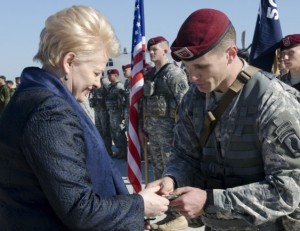
Lithuanian president Dalia Grybauskaite greets the 173rd Airborne Brigade during a deployment to deter Russia.
That has to change, said Perkins. Instead of waiting for War College to teach strategic issues, the service needs to imbue strategic awareness from the start. “We have this company commander from the 173rd [Airborne Brigade] meeting with the president of Lithuania,” Perkins told reporters at AUSA. “He has to understand the strategic aspect, [and] that has been a failing in previous Army Operating Concepts.”
So the new Army Operating Concept released this month, Win In A Complex World, makes a point of addressing strategy. “This concept, for the first time, focuses on all three levels of war; tactical, operational, and strategic,” Perkins writes in his foreword. “The problem we are focusing on is how to ‘Win in a Complex World’ [and] ‘Win’ occurs at the strategic level.”
That new emphasis on strategy, however, has implications for how the military deals with its civilian masters.
“There’s a lot of lies in military doctrine,” said former Pentagon official Janine Davidson at the AUSA panel on the new concept. “There’s a lot of myths…that basically tell you all the civilians are somehow divinely inspired enough to know exactly what endstate they want when something bad happens.” Not so, she said. “When the civilians look to the military leadership for answers, they want options…they want creativity — and this is also what I see in this concept.”
“We, the Army, need to provide our policymakers multiple options,” not “ultimatums,” Perkins said at AUSA. But what kind of “creative” input does the military need to offer? Since war is an extension of politics and a contest of wills, Perkins said, invoking Clausewitz, any savvy enemy will target America’s political will to fight. That means US military leaders have to understand domestic politics and what military options it can stomach, he said: “You have to influence the US policymakers’ political risk analysis.” (Emphasis mine).
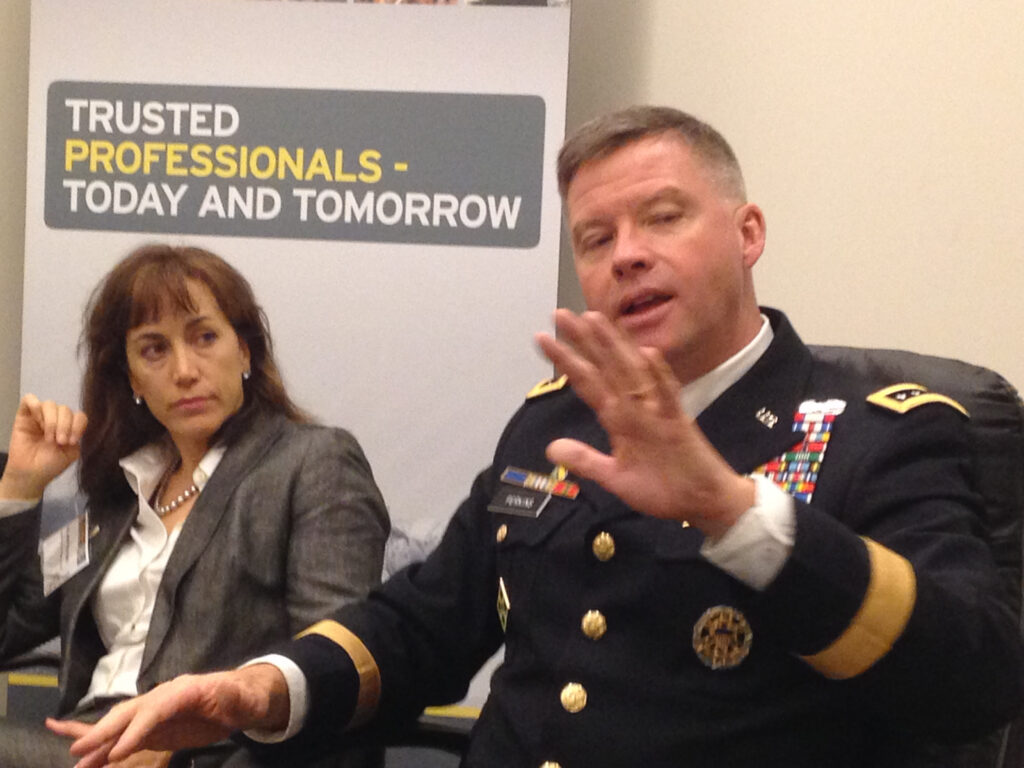
Janine Davidson and Gen. David Perkins at AUSA.
The Enduring Advantage
The generals’ new willingness to question politicians is the high-level analog to soldiers’ new willingness to question the generals. TRADOC is now seeking to cultivate “critical thinking” from boot camp up. “It’s inadequate to say, ‘well, it ought to be an elective at the War College,'” Gen. Perkins said during a panel discussion at AUSA. “We’re actually changing aspects of basic training so they have to start applying critical thinking skills between the bus and the drill sergeant.”
By contrast, Perkins says, when he was a young lieutenant in West Germany during the Cold War, what the Army wanted from him was not critical thinking but compliance: precise execution of a predefined plan against the thoroughly studied and slow-changing Soviet Union. But even the stodgy Russians are making surprising use of proxies and hackers these days. Compliance without creativity won’t cut it anymore.
“What you can do is train in ways and develop leaders in ways that allow them to adapt to whatever the circumstances are,” said McMaster, Perkins’ deputy, when I caught him in the halls at AUSA. Officers will still learn conventional combined-arms warfare using infantry, tanks, artillery, and air support in lightning maneuvers — skills eroded over a decade of counterinsurgency — “but we place these [training scenarios] now in the kind of complex environments that replicate all those human, social, political dynamics we have to consider….as an integral part of war and warfare, not as something separate.”
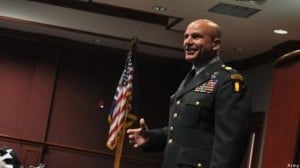
Lt. Gen. H.R. McMaster
What kind of war should those troops be training for, precisely? With a frankness that’s refreshing — if hardly reassuring — the new Army Operating Concept says that we don’t know:
“The environment the Army will operate in is unknown. The enemy is unknown, the location is unknown, and the coalitions involved are unknown,” Perkins writes in his foreword. Indeed, although the concept only makes this point implicitly, it’s even unknown whether the US military will still enjoy the across-the-board technological superiority — aka “overmatch” — it’s counted on for decades. It probably won’t. But if technology isn’t our enduring advantage, what is?
“We want to have the best technology to overmatch the enemy,” McMaster told me. “Obviously, in an activity that involves killing and the prospect of death, right, you want to make sure you can have overmatch, [but] our competitive advantage is not any single technology, it’s how we combine…different technologies together in combined arms and joint operations.” That requires a level of skill and inter-service cooperation that adversaries can’t easily replicate, no matter how much technology they buy or steal.
“We are the best at doing the whole joint thing,” Perkins told reporters. “Though not perfect…. we probably do it better than anybody else and we’ve been forced to do it since [the] Goldwater-Nichols [Act of 1986].”
“We don’t want to lose that,” Perkins continued. “In fact, we want to get even better at it — which is not what usually happens during interwar periods: You generally go back to your corners because it’s all about competition for resources.”
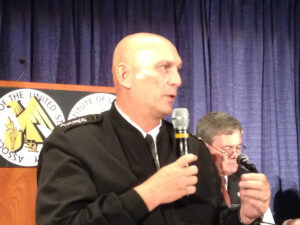
Gen. Ray Odierno unexpectedly takes the floor at AUSA.
Getting Beyond The Budget Wars
Some skeptics, myself included, wondered how the Army could even think about the future when it’s fighting for every dollar today.
Both the war abroad — the need to train and equip those fighting in Afghanistan — and the war at home — sequestration and other budget pressures — have greatly complicated the Army’s ability to plan, Flournoy told Colin Clark. “I’m told the Army last year did seven POMSs [Program Objective Memorandums, the five-year budget plan]. If you’re doing that, there isn’t much bandwidth left….You are trying to simply survive today.”
No less a figure than the Army Chief of Staff acknowledged the problem when he unexpectedly took the floor at the AUSA panel. “Everybody’s heard my feelings on sequestration,” said Gen. Ray Odierno, “[but] the Army Operating Concept is based on what we believe the future environment we’re going to have to operate in…no matter how much money we have.”
In fact, thinking through the future “becomes more important the less money we have,” Odierno said. “The one thing we can’t ever back off on is leader development and our ability to continue to adjust and adapt.”
Since 1775, the enduring advantage of the American soldier has been his ability to take initiative, innovate, and adapt, without waiting for orders — or even necessarily following the orders he had. Since George Washington took command, the Army’s enduring dilemma has been how to reconcile that initiative with a disciplined professional force. That is the challenge the new doctrine takes on.
Colin Clark also contributed to this story.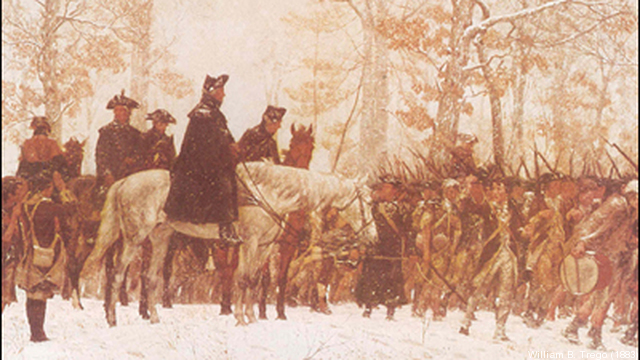
Move over FARA: General Atomics pitching new Gray Eagle version for armed scout mission
General Atomics will also showcase its Mojave demonstrator for the first time during the Army Aviation Association of America conference in Denver, a company spokesman said.


























